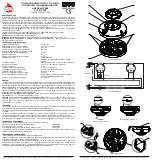
Panasonic Electric Works Nordic AB
MEW01091
Rev: 3
EBL128 Operating Instructions V1.1.x
8
2
Definitions / Explanations
Definitions / explanations / abbreviations / etc. frequently used or not
explained elsewhere in the document.
2.1
PEWN AB
P
anasonic
E
lectric
W
orks
N
ordic
AB
2.2
Alarm point
Unit, which can generate a fire alarm in EBL128, i.e. a sensor, a
conventional detector, a manual call point, etc.
2.2.1
Smoke detector
Two types of analog and conventional smoke detectors are available:
photo electric (optical) and ionization.
2.2.2
Sensor
Sensor = Analog detector
2.2.3
Analog detector
Contains an A/D-converter. EBL128 pick up the digital values
("sensor values") for each detector individually. All evaluations and
"decisions" are then made in EBL128. Analog detectors are
addressable – an address setting tool is used. An analog detector has
to be plugged in an ASB.
2.2.4
(Analog) Sensor Base (ASB)
A sensor is plugged in an ASB, which is connected to a COM loop
(see below).
2.2.5
Conventional detector
Detector with two states, normal or fire alarm. The detector contains a
closing contact and a series alarm resistor. Some types are plugged in
a
CDB
(see below) but some types are water proof and are not
plugged in any base.
(Conventional detectors are normally plugged in a
CDB
(see below)
and connected to a conventional zone line with end-of-line device.)
2.2.6
Conventional Detector Base (CDB)
A conventional detector is plugged in a CDB and connected to a
conventional zone line input.
2.2.7
Addressable
A unit with a built-in address device (e.g. a manual call point). Each
unit is individually identified, handled and indicated in EBL128
(The unit can consequently be an I/O unit, to which one or more
conventional "alarm points" can be connected on the zone line.).
































